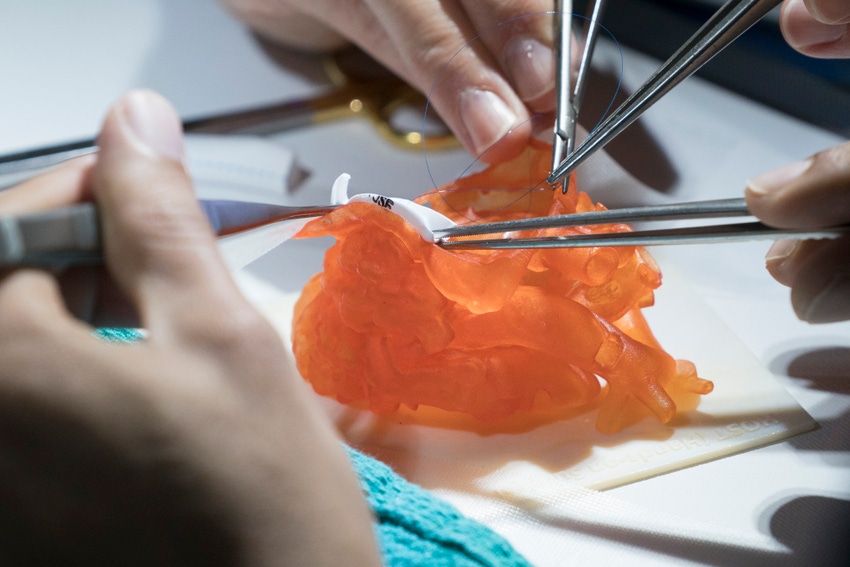Stratasys has introduced BioMimics, a suite of 3D printing technologies that allow it to 3D print models of organs that look and feel like the real thing.
February 2, 2018

Medical researchers are always looking for better, more efficient ways to train surgeons and clinicians beyond using human cadavers and real human organs. While some companies are looking at virtual reality and simulation as a solution, others are tackling the challenge of creating more realistic physical models for clinicians to work with.
To this end, 3D printing technology company Stratasys has debuted BioMimics, a suite of proprietary materials along with software and 3D printing solutions that can create artificial, 3D-printed organ models with properties nearly identical to their real world counterparts – both in soft tissue and bone. This is achieved by moving away from rigid plastics typical of 3D-printed organ models and by combining new printing materials with Statasys' PolyJet 3D printers.
|
Using a combination of software algorithms and proprietary materials, Statasys is able to 3D print model organs that mimic the physical properties of the real thing. Shown: surgical trainees at SickKids pediatric hospital in Toronto, Canada practice on 3D printed heart with congenital defect (Image source: Stratasys) |
“Testing innovative medical devices, teaching principles of surgery, providing continuing medical education, and demonstrating new products to clinicians all require ‘bench-top’ models that simulate human bodies and diseases. Much like simulation and co-piloting builds expertise for pilots, medical practitioners hone skills throughout their careers to provide exceptional care,” Scott Rader, General Manager of Healthcare Solutions at Stratasys, said in a press statement. “The challenges of today’s solutions include animal models that only approximate human anatomy, and cadavers that don’t retain the live-tissue feel and often lack targeted pathology.”
Michael Gaisford, Director of Marketing, Healthcare Solutions at Statasys, who will be speaking about Stratasys BioMimics at the upcoming Pacific Design and Manufacturing Conference in Anaheim, Calif, told Design News this latest development from Stratasys builds on research that goes back to the earliest days of 3D printing. “3D printing organ models goes back a couple of decades,” he said. “It was one of the earliest applications of 3D printing.”
A big hurdle to printing realistic organ models, Gaisford said, has always been converting patient data into something printable. 3D-printed organs have been commonly used to create tangible models of actual patient organs to allow doctors a chance at better diagnosis and training and pre-planning for surgery. However, when the data from a CT or MRI scan is converted to a STL file for a 3D printer a lot gets lost in the translation.
“When converting a bone from a CT to a STL file, for example, you end up really simplifying the thing,” Gaisford explained. “You get kind of a homogeneous printout on the other end. Thankfully, today we've overcome this with advanced software and capabilities.”
On the software end, BioMimics is based on an algorithm that can replicate the intricate details of organs and bones. Gaisford said Stratasys is constantly taking in feedback from its customers to better adjust the algorithm for even more accurate and realistic models. “The good thing about working with surgeons is that they are very exacting and have very high expectations,” he said. “They will tell us things like how a bone should crunch or how a tissue should respond when a screw is inserted in it. We've worked on real life scenarios with medical device makers, hospitals, and researchers and we keep a continuous feedback loop with our customers to adjust the algorithm on an iterative basis.”
The combination of software and the development of proprietary new 3D printing materials has allowed Statasys to 3D print models as complicated as a human spine. “The spine model integrates so many complex elements, from varying cortical strengths and thicknesses, to tactile bone response, to soft issue and intervertebral discs,” Gaisford said. From there Gaisford said Stratasys can print the model to reflect a number of medical conditions. “We can replicate and vary it into things like a degenerative disc model or a scoliotic spine model for training surgeons.”
While Stratasys may be the first to commercialize realistic, 3D-printed organ models other entities have been developing similar technology as well. A team researchers from the University of Minnesota is currently seeking a patent on a process for 3D printing lifelike organ models using a custom 3D printer and a combination of silicon-based inks and soft, 3D-printed sensors. The University of Minnesota researchers hope their process can be expanded beyond modeling and also be used to create working artificial organs for transplants.
Stratasys currently only offers BioMimics to customers directly as a service, but Gaisford says that down the road the company plans to release a commercial 3D printer specialized in printing organ models. The company is also looking into launching studies to compare the efficacy and outcomes of training with BioMimics models versus typical cadaver training as well as virtual reality training.
|
Chris Wiltz is a Senior Editor at Design News , covering emerging technologies including AI, VR/AR, and robotics.
About the Author(s)
You May Also Like





